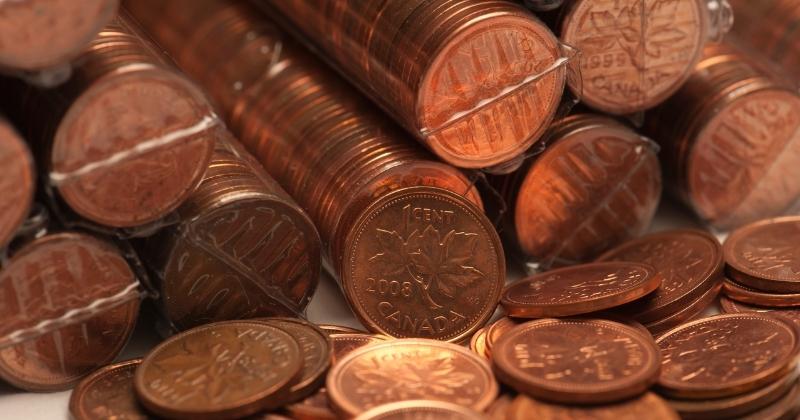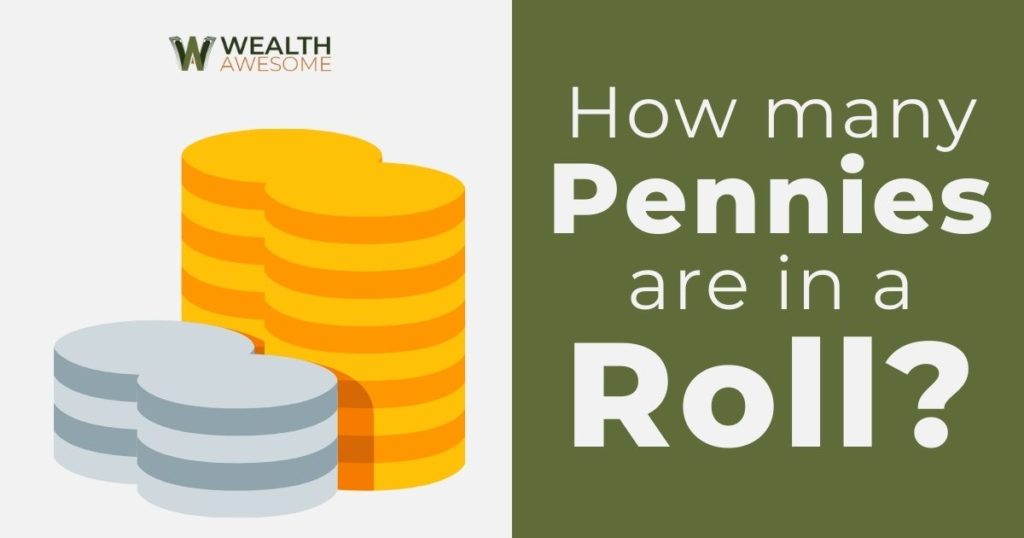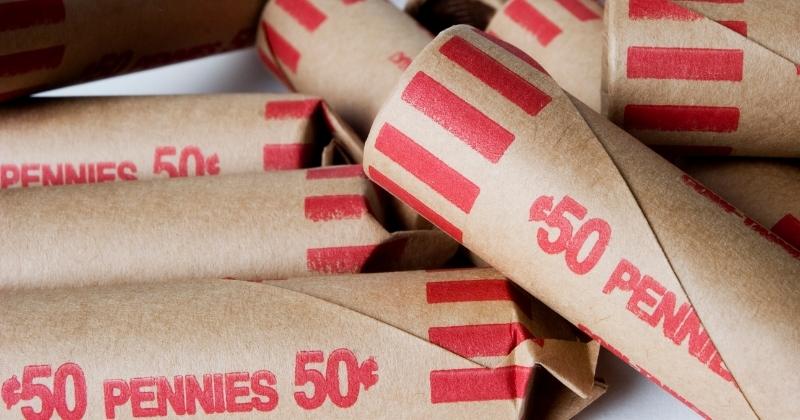Do you always seem to accumulate lots of pennies? Even though the penny has been phased out, I always seem to have pennies lying around.
While that pile of coins might weigh your pockets down, rolling it up and taking it to the bank can help pad your savings account.
Even though it’s not the norm to carry cash these days, saving your coins can add up. In fact, isn’t that one of the first financial lessons you learn when you’re a kid – save your pennies for a rainy day?
Well, here’s your chance to save those pennies, roll them up, and cash out.
But just how many pennies are in a roll in Canada? Let’s find out here.
How Many Pennies are in a Roll in Canada?
There are 50 pennies in a roll in Canada. The monetary value of this roll of pennies is 50 cents, or $0.50. This is what most banks in Canada will accept as a roll of pennies.
Why Phase Out the Penny?
While the penny is still considered legal tender in Canada, it’s not as common as it once was. In 2013, The Royal Canadian Mint stopped producing and distributing pennies throughout Canada. Why did they do it? There are several reasons including:
- Rising costs of producing the penny in relation to its value.
- Penny accumulation in households.
- Handling costs for retailers and financial institutions.
According to The Mint, the estimated savings associated with this phase-out is estimated to be $11 million per year.
So what happens with pennies still in circulation? Well, the penny will keep its value indefinitely, and you can still use them at businesses that accept them. If a business does not allow the currency use, they can either round up or down to the nearest five-cent increment when consumers purchase items.
What Materials Make Up the Penny?
Since its advent, the penny has been made of many different materials and included many designs. Since 2000, the penny composition comprised of 94% steel.
However, the penny’s composition consisted of at least 95.5% copper until 1997, when it changed to 98.4% zinc with a copper plating.
What Happens to Pennies Turned Into the Banks?

After the phase-out started, many customers wrapped up their pennies and took them to the bank. Most banks still accept pennies – as long as they’re rolled and ready for deposit.
In turn, the banks turn over those pennies to the Mint, and they recycle them. The Mint has a contract with an iron and metal company that uses magnets to separate the pennies based on their metal components.
From there, the pennies are melted down and resold to various industrial sectors looking for zinc, copper, and steel. This is a lucrative business, and the Canadian government initially estimated it would bring in around $42.5 million in revenue.
Other Currency Phased Out
With more people using debit and credit cards to make purchases, it’s only natural that currency use changes with the times. While the penny is slowly phasing out, it is not the first piece of Canadian money to lose its dominance.
Back in 2019, the Bank of Canada announced that it would remove legal tender status from various older notes starting in January 2021. The following notes were affected:

Since most of the notes haven’t been produced for years and were not used in everyday regular transactions, most Canadians weren’t really affected by the changes.
In its press release, the Bank of Canada made it clear that if Canadians still had these notes, they weren’t without value. “Importantly, these banknotes will not lose their value.
Canadians can redeem them at face value or decide to keep them. Those who wish to redeem their banknotes can do so most easily at their financial institution. They can also send banknotes directly to the Bank of Canada.”
Some of the reasons to crack down on the circulation of these older notes include preventing counterfeiting and money laundering. Newer bills have better security features and make them harder to replicate, cutting down on fake bills and other scams.
In addition, some of the older notes have seen better days and aren’t in the best shape. If you don’t exchange your tender at a local bank, you may end up sitting on a pile of worthless money.
How Many Rolls of Pennies Is $50 In Canada?
Pennies come packaged in rolls of 50, so that means one roll is 50 cents. In order to get $50, you would need 5,000 pennies and 100 rolls. But before you get to work saving your money and rolling all your change, be aware that Canada started phasing out the penny back in 2013.
Which Coins Are Still in Circulation?
With the penny on its way out, Canadians still have access to five other coins. Check out this summary of each, along with the coins’ composition and a brief fact.
- Loonie (one dollar) – Dollars used to be paper bills but were phased out back in the 1980s when the Loonie first hit the scene. The coin is made from a gold-coloured nickel and features a picture of a loon – Canada’s national bird and the reason for the coin’s name.
- Toonie (two dollars) – The Toonie, the two-dollar coin, has an outer ring made from pure nickel that surrounds a copper alloy middle. It replaced the two-dollar bill in the 1990s and features a polar bear on one side.
- Quarter – The 25 cent piece features a caribou on one side – a change that dates back to 1936. The quarter is made up of mostly steel but also has small amounts of copper and nickel plating.
- Dime – Worth ten cents, the dime is the smallest of all coins still in use. The dime’s composition is similar to the quarter – mostly steel with small amounts of copper and nickel plating. The sailboat featured on one side is the famous Bluenose, once the world’s fastest racing ship.
- Nickel – Because of its name, you might assume the nickel contains nickel – but you’d be wrong. It currently consists of mostly steel, but at one time, it was made of nickel, and how it got its name.
The History of the Penny

Back in the 1800s in Canada, coins in circulation were a mish-mash of British, American, and Spanish currency. To begin to introduce a Canadian monetary system, the one-cent piece, or penny, was born in 1858.
That first penny was lightweight and larger than the modern-day quarter. It featured a young Queen Victoria on one side and started the tradition of regularly displaying a reigning monarch. With so many coins minted between 1858 and 1859, producing more coins didn’t need to happen until 1876.
The penny changed to its current size in 1920. This change helped save on copper and gave the penny the same size as the American version.
The current version of the penny was designed in 1937 and features the two maple leaves known throughout Canada. Over the years, the coin changed to mark important dates – most notably, the country’s centennial, which featured a dove on the front of the coin.
One of the most alluring tales of the penny comes from a 1936 minting. The story states that three coins were minted with a dot below their 1936 date as a prototype for a potential production following George V’s sudden death.
When his successor, Edward VIII, abdicated the throne at the end of 1936, officials worried about a production gap since they didn’t have a portrait prepared of the next reigning monarch, George VI. Instead, they planned to reuse the 1936 George V portrait with a dot underneath to differentiate between batches.
For reasons unknown, the plan never materialized, and only three of the “dot cent” pieces remained. In 2010, someone purchased one of the coins for $402,500 US.
Coin Rolling Turned Into a Hobby

While coin rolling can be a chore, some coin collectors and treasure hunters have taken to hunting through coin rolls for valuable tender.
To start the hunt, most pros advise you to visit your local bank or credit union to get rolls of coins. Many banks will require you to have an account with them before they fork over any money.
Seasoned hunters will look for rare minted coins along with those that are made from valuable materials – like pure silver. If you’re looking for more information on how to get started, check out this YouTube video for tips.
My Conclusion on How Many Pennies Are In A Roll In Canada
Rolling change might not be the most exciting pastime, but cashing in all that dough could make you some serious bank.
Here’s a master list of how many coins are in a roll for the nickel, dime, quarter, loonie and toonie.
Once you have all that money, make sure you have the best place to store it. Check out these top no-fee bank accounts.




